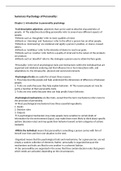Summary
Summary and lecture notes Personality Psychology Domains of Knowledge about Human Nature
- Course
- Institution
- Book
This summary covers all exam aspects of the course Psychology of Personality at Tilburg University. I passed the course with a 8.5 so hopefully this summary will help you pass the course as well!
[Show more]




